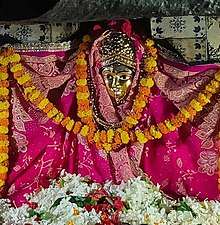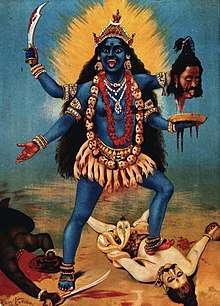Maa Tara Chandi Temple
Maa Tara Chandi Temple is a Hindu temple dedicated to Maa Shakti or Maa Durga, located in Sasaram, Bihar, India. It is one of the 51 Shakti Peetha.[1][2][3]
| Maa Tara Chandi Mandir | |
|---|---|
 | |
| Religion | |
| Affiliation | Hinduism |
| District | Rohtas |
| Deity | Durga maa Sati, Adi Parashakti, Shakti, Devi, Kali, Parvati, Tara |
| Festivals | Navratri, Maha Shivaratri |
| Governing body | Maa Tara Chandi Temple Committee, Sasaram |
| Location | |
| Location | Sasaram, Bihar, India |
| State | Bihar |
| Country | |
 Shown within Bihar  Maa Tara Chandi Temple (India) | |
| Geographic coordinates | 24.95°N 84.03°E |
| Architecture | |
| Type | CaveTemple, MountainTemple |
| Completed | Dvapara Yuga |
| Specifications | |
| Temple(s) | 1 |
| Elevation | 110 m (361 ft) |
| Website | |
| http://m.sasaramonline.in/city-guide/maa-tara-chandi-temple-in-sasaram | |
History
Maa Tarachandi Shakti Peetha, also called Maa Tarachandi, is the oldest and one of the most sacred temples of Sasaram. It is regarded as one of the 51 Siddha Shakti Pithas in India. According to Pauranic legends, the "right eye" (Netra) of the corpse of Sati had fallen here when it was chopped off by Lord Vishnu with his "Sudarshan Chakra". The ancient temple, originally called Maa Sati, is believed to be the abode of the goddess Durga Maa Tara Chandi.
The Kaimur Hills provide an access to many other attractions of Sasaram like Gupta Mahadev Temple, Parvati Temple, ancient caves, Manjhar Kund and Dhua Kund are two waterfalls of this town that have the capacity of generating large amounts of electricity.[4]
Shakti Peetha
The Shakti Peetha (Sanskrit: शक्ति पीठ, Śakti Pīṭha,[5] seat of Shakti is a place of worship consecrated ashes of the goddess Shakti or Sati, the female principal of Hinduism and the main deity of the Shakta sect. They are sprinkled throughout the Indian subcontinent.[2]
Location
There is a temple of Goddess Tarachandi, about 5 km from Sasaram two miles to the south, and an inscription of Pratapdhavala on the rock close to the temple of Chandi Devi. Hindus in large number assemble to worship the goddess. Dhuwan Kund, located about 36 km south-west of this town, is a nearby tourist attraction.[6]
References
- http://ww.itimes.com/places/tara-chandi-temple
- http://m.holidayiq.com/Maa-Tara-Chandi-Temple-Sasaram-Sightseeing-759-15459.html
- "Archived copy". Archived from the original on 2017-05-10. Retrieved 2016-09-29.CS1 maint: archived copy as title (link)
- "Tara Chandi Temple Rohtas - Temples in Rohtas, Attractions in Rohtas bihar". hoparoundindia.com. Archived from the original on 29 June 2013. Retrieved 24 September 2016.
- name="Fuller2004">Fuller, Christopher John (2004). The Camphor Flame: Popular Hinduism and Society in India. Princeton: Princeton University Press. p. 44. ISBN 978-0-691-12048-5.
- https://www.tripadvisor.in/Attraction_Review-g1985450-d3727489-Reviews-Maa_Tara_Chandi_Temple-Sasaram_Bihar.html




